Monday 19 December, 2016, 13:59 - Amateur Radio, Broadcasting, Spectrum Management
Posted by Administrator
Posted by Administrator
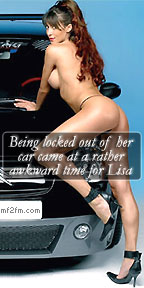 Wireless Waffle last discussed the issue of interference to and from wireless car keys and other similar devices back in 2013, but the topic has cropped up here almost since time immemorial. The original articles discussed the fact that the frequency band used for these devices (around 433.925 MHz) was shared with radio amateurs and that not only were the radio amateurs suffering from interference but that there were cases of car users getting stuck either unable to lock or unlock their cars due to nearby amateur radio transmissions.
Wireless Waffle last discussed the issue of interference to and from wireless car keys and other similar devices back in 2013, but the topic has cropped up here almost since time immemorial. The original articles discussed the fact that the frequency band used for these devices (around 433.925 MHz) was shared with radio amateurs and that not only were the radio amateurs suffering from interference but that there were cases of car users getting stuck either unable to lock or unlock their cars due to nearby amateur radio transmissions.But it seems that the situation has changed and that criminals have cottoned on to the fact that it's possible to jam the transmissions between cars and their keys to their benefit. The BBC reports that thieves in a car park in Berkshire had been 'using car key jammers' and also provides useful advice on the impact and implications of car key jammers.
Now far be it for Wireless Waffle to condone such activities, but it is so brain-achingly simple, and mind-bogglingly cheap, to jam these signals, that it's a surprise that it has taken criminals so long to figure out how to do it.
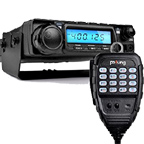 Transmissions from car key fobs normally use either amplitude modulation or fairly crude frequency modulation and the transmitters have a power level of no more than 10 milliWatts. The receivers in the vehicles are manufactured to a price point of around 50 pence and are woefully inadequate at protecting against interference. Thus, a strong enough signal on the same frequency as the car key transmitter (or indeed on a neighbouring one) will overwhealm the low power transmission from the keys. A 40 Watt transmitter (4000 times stronger than the signal from the keys) operating in the same band can be purchased on-line for little more than GBP100.
Transmissions from car key fobs normally use either amplitude modulation or fairly crude frequency modulation and the transmitters have a power level of no more than 10 milliWatts. The receivers in the vehicles are manufactured to a price point of around 50 pence and are woefully inadequate at protecting against interference. Thus, a strong enough signal on the same frequency as the car key transmitter (or indeed on a neighbouring one) will overwhealm the low power transmission from the keys. A 40 Watt transmitter (4000 times stronger than the signal from the keys) operating in the same band can be purchased on-line for little more than GBP100. Such a transmitter would be a brute force way to stop the receiver in the car from being able to hear the signal from the key. This would stop the key from being able to lock the car, meaning that an unsuspecting driver could get out of the car and casually press the button on their key and walk away without listening for the corresponding 'clunk' of the car locking, not realising that the car has not locked. This would clearly leave the car unlocked and easy pickings for a thief.
In principal it would be easy to go one stage further. With a simple receiver it would be possible to record the transmission from the key, and using a low power transmitter, it would be feasible to re-create the signal. In this case, it would be possible for a criminal to unlock a car after it had been safely locked by the driver. Don't say we didn't warn you.
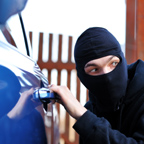 This is not just possible for car keys, but for any devices which operate in a similar manner. The 433 MHz band used for these devices is replete with a variety of signals from wireless devices such as garage doors, parking barriers and devices for which an attack would be less significant such as weather stations and doorbells. The chart below (known as a waterfall chart) shows, from top to bottom, around 2 minutes of time, and from left to right, the middle portion of the 433 MHz band. A wide range of different transmissions are shown as bars or dots and it is clear there's plenty afoot here despite the transmission area of the devices being very small and thus the limited number of devices in range of the receiver used to perform this scan.
This is not just possible for car keys, but for any devices which operate in a similar manner. The 433 MHz band used for these devices is replete with a variety of signals from wireless devices such as garage doors, parking barriers and devices for which an attack would be less significant such as weather stations and doorbells. The chart below (known as a waterfall chart) shows, from top to bottom, around 2 minutes of time, and from left to right, the middle portion of the 433 MHz band. A wide range of different transmissions are shown as bars or dots and it is clear there's plenty afoot here despite the transmission area of the devices being very small and thus the limited number of devices in range of the receiver used to perform this scan. 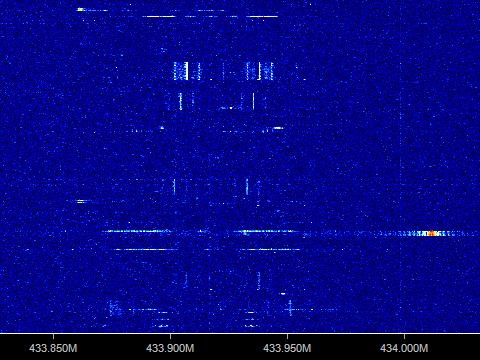
As the number and variety of wireless devices increases, in particular as we progress to the world of the 'Internet of Things' in which there will be sensors and actuators everywhere, it is clear that the security of wireless connections needs beefing up. If you are concerned about your car being 'hacked' by criminals, the best way is to disable the convenience of the wireless key locks and return to the old-fashioned technique of putting the key for your car into the door. Sadly, some modern cars don't actually have this feature any more!
3 comments
( 967 views )
| permalink
| 



 ( 2.9 / 9289 )
( 2.9 / 9289 )




 ( 2.9 / 9289 )
( 2.9 / 9289 )
Wednesday 26 October, 2016, 19:12 - Spectrum Management
Posted by Administrator
It seems that consultants RealWireless have been at it again. At what again, you ask? Back in May 2014, Wireless Waffle reported that a report, produced for Ofcom had been modified to seemingly correct a factor of 1000 error in the forecasts for future mobile data traffic thus fatally skewing their forecasts for the amount of spectrum needed for mobile services.Posted by Administrator
This time, in a new report for the European Commission entitled, 'Identification and quantification of key socio-economic data to support strategic planning for the
introduction of 5G in Europe' (admittedly led by Tech4i˛ but where you can bet your bottom dollar that RealWireless were the spectrum experts), the mathematical brainiacs have declared that the amount of radio spectrum required for the next generation of mobile service (5G) by 2025 will be between 19 and 76 GHz depending on the 'sharing scenario', meaning that if operators are prepared to get along nicely and co-operate to use the same spectrum, somewhat less will be needed (as if that is going to happen!)
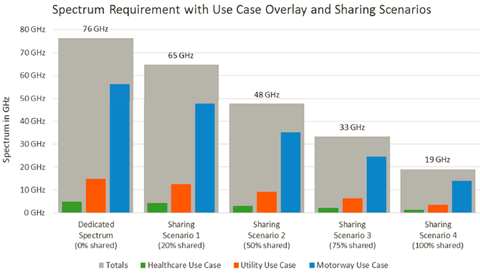
 The report specifically considered a number of scenarios and concluded that it is in the use of 5G on motorways where the demand for spectrum is highest. This is based on the notion that there are :
The report specifically considered a number of scenarios and concluded that it is in the use of 5G on motorways where the demand for spectrum is highest. This is based on the notion that there are :1000 vehicles along a 1km stretch of motorway, most of which (75%) are using high rate (4K/UHD) and pervasive video applications and devices operating simultaneously in vehicles. The usage in vehicles on a busy motorway within a Smart City with traffic building up due to an accident, is estimated to be 215 Mbps per vehicle as described in the transport ‘day in the life of’ story.
Er, firstly, it doesn't take 215 Mbps to deliver 4K/UHD video: Netflix purportedly manage to deliver 4K video at 18 Mbps, so what is the other 200 Mbps per vehicle for? Obviously that is the driver playing 'Interactive 4D Battle Death Wars XIV' which streams live data from 200 other players to create a 'fully-immersive real-time near-death experience'. Obviously the driver can do this because the car drives itself.
Of course the amount of spectrum needed to deliver this connectivity, even if it did prove necessary, could be reduced by increasing the number of base stations. One every 4 to 5 metres should do it.
These silly preductions, and it's not just RealWireless, because based on the latest ITU estimates, we will all be streaming 4K video 24 hours of every day by 2043, are designed for one purpose only: to allow the mobile industry, most notably the manufacturers of network infrastructure (such as Ericsson and Huawei) to convince the world that more spectrum is needed, so that they can flog a load more of new equipment.
 Are the mobile operators themselves clamouring for new spectrum? There is little evidence to suggest that they are. The latest spectrum auction in the US has failed, so far, to raise enough money from the mobile operators to pay the broadcasters to budge over and make way for the 'big boys'. And there are several spectrum bands that have been available for mobile services for 10 years or more (notably the 2 GHz TDD bands, and the 3.4-3.6 GHz band) for which no widespread services have been launched.
Are the mobile operators themselves clamouring for new spectrum? There is little evidence to suggest that they are. The latest spectrum auction in the US has failed, so far, to raise enough money from the mobile operators to pay the broadcasters to budge over and make way for the 'big boys'. And there are several spectrum bands that have been available for mobile services for 10 years or more (notably the 2 GHz TDD bands, and the 3.4-3.6 GHz band) for which no widespread services have been launched.It's hard to see how the estimated 76 GHz of spectrum could possibly be needed in 9 years time, and even less so, why operators would invest in spectrum and infrastructure to allow bored drivers to play 'Interactive 4D Battle Death Wars' whilst stuck in a traffic jam. Wireless Waffle predicts that the real amount of spectrum needed by 2025 will be at least 10 times less than this. So, the gauntlet has been thrown down, let's come back in 2026 and see who was right!
Since the 1980s, extensive amounts of time and resources around the world have been focussed on the search for extra-terrestrial intelligence (SETI). One of the primary methods of doing so, is listening for radio transmissions from far away worlds. But how do you decide what frequencies to listen on?
 The main frequency that SETIologists believe would be the primary real-estate for aliens wishing to make themselves known is around what is termed the 'water-hole' at frequencies close to 1.5 GHz. This frequency range includes the so-called hydrogen line (1420.4 MHz) and hydroxyl line (1666 MHz) which are frequencies that are generated by naturally occuring processes within atoms. The other advantage is that Earth's atmosphere, which comprises quite a large percentage of water, is relatively transparent at these frequencies making Earth based observations easier. The logic is that any intelligent life would be as aware of these lines in the spectrum as we are, and would figure that these are good places to transmit. Whether the transparency of the atmosphere at these frequencies on the planets they inhabit would also point them in the direction of the water-hole is a moot point.
The main frequency that SETIologists believe would be the primary real-estate for aliens wishing to make themselves known is around what is termed the 'water-hole' at frequencies close to 1.5 GHz. This frequency range includes the so-called hydrogen line (1420.4 MHz) and hydroxyl line (1666 MHz) which are frequencies that are generated by naturally occuring processes within atoms. The other advantage is that Earth's atmosphere, which comprises quite a large percentage of water, is relatively transparent at these frequencies making Earth based observations easier. The logic is that any intelligent life would be as aware of these lines in the spectrum as we are, and would figure that these are good places to transmit. Whether the transparency of the atmosphere at these frequencies on the planets they inhabit would also point them in the direction of the water-hole is a moot point.
Other frequencies that have been considered are twice the water-hole frequencies (after all, intelligent life would surely be able to multiply by 2 - assuming their number system used the same integers as we do), or 4.462 GHz which is the hydrogen line times pi (because circles are a universal phenomena, right?)
But could we actually receive a transmission on such a frequency? Let's do the link budget calculation...
But path loss is dependent on frequency, and so if a lower frequency was used, say 100 kHz instead of 1500 MHz, the path loss (from Alpha) drops from 368 dB to a more managable 284 dB (84 dB less). Unfortunately the gain of the receive dish also falls from 51 dB to a measly -33 dB (also 84 dB different). But instead of a dish, we could use a long-wire to receive the signals, at 1.5 km long, it would have a gain of 2 dBi, so overall we would gain 33 dB in our link budget calculation.
"A-ha", you say, "but the transmitting antenna would have a lower gain too, so nobody really wins. If I do the maths right, the required transmitter power is now 284+0+0-168 which is 116 dBm or 400 MegaWatts, which is a bit far fetched isn't it?" Maybe, but it's easier to generate 400 Megawatts at 100 kHz than it is at 1.5 GHz (or it is for humans anyway). In fact, this kind of power is generated every day on Earth by... lightning storms.
It may come as no surprise, therefore, that researchers at the University of St Andrews believe that signals that were received in 2009 from exoplanet HAT-P-11b might well have been caused by lightning storms on the distant planet. But what use is this, it doesn't represent extra-terrestrial intelligence, just extra-terrestrial weather (and we already know that even the other planets in our own solar system exhibit different weather characteristics).
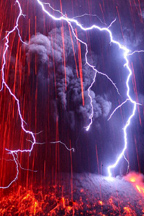 The point, if there is one, is that if we could modulate lightening storms, or perhaps induce them in a way that allowed them to occur in a predictable fashion, we could make signals big enough to be transmitted across inter-stellar space. According to Climate Viewer:
The point, if there is one, is that if we could modulate lightening storms, or perhaps induce them in a way that allowed them to occur in a predictable fashion, we could make signals big enough to be transmitted across inter-stellar space. According to Climate Viewer:
But if lightning can be heard many light years away, perhaps these artificially induced lightning strikes are nothing to do with their stated objective but are actually to 'send messages extra-terrestrially'. Maybe the signals received from HAT-P-11b are not just random lightning storms and despite the Daily Mail claiming that these are not messages from space, perhaps they are an attempt at communication after all. After all, stranger things have been true!
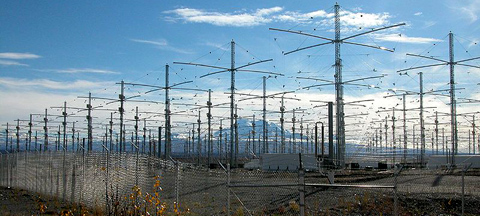
 The main frequency that SETIologists believe would be the primary real-estate for aliens wishing to make themselves known is around what is termed the 'water-hole' at frequencies close to 1.5 GHz. This frequency range includes the so-called hydrogen line (1420.4 MHz) and hydroxyl line (1666 MHz) which are frequencies that are generated by naturally occuring processes within atoms. The other advantage is that Earth's atmosphere, which comprises quite a large percentage of water, is relatively transparent at these frequencies making Earth based observations easier. The logic is that any intelligent life would be as aware of these lines in the spectrum as we are, and would figure that these are good places to transmit. Whether the transparency of the atmosphere at these frequencies on the planets they inhabit would also point them in the direction of the water-hole is a moot point.
The main frequency that SETIologists believe would be the primary real-estate for aliens wishing to make themselves known is around what is termed the 'water-hole' at frequencies close to 1.5 GHz. This frequency range includes the so-called hydrogen line (1420.4 MHz) and hydroxyl line (1666 MHz) which are frequencies that are generated by naturally occuring processes within atoms. The other advantage is that Earth's atmosphere, which comprises quite a large percentage of water, is relatively transparent at these frequencies making Earth based observations easier. The logic is that any intelligent life would be as aware of these lines in the spectrum as we are, and would figure that these are good places to transmit. Whether the transparency of the atmosphere at these frequencies on the planets they inhabit would also point them in the direction of the water-hole is a moot point.Other frequencies that have been considered are twice the water-hole frequencies (after all, intelligent life would surely be able to multiply by 2 - assuming their number system used the same integers as we do), or 4.462 GHz which is the hydrogen line times pi (because circles are a universal phenomena, right?)
But could we actually receive a transmission on such a frequency? Let's do the link budget calculation...
- The path loss from our nearest star, Alpha Centauri, which is 4.37 light years (41,315,094,156,000 km) away at 1.5 GHz is 368 dB.
- If we use a BIG dish, say 30 metres in diameter, to receive the signal, it would have a gain of 51 dBi.
- Let's also assume that the aliens are transmitting using a similar sized dish (and they are pointing it directly at Earth).
- If the signal is very low bandwidth data (say 100 bits per second) we would need a receiver bandwidth of around 100 Hz, giving a noise floor for a cryogenically cooled receiver of -168 dBm.
- The necessary transmitter power to overcome the noise is therefore 368-51-51-168 or 98 dBm or 6.3 MegaWatts.
But path loss is dependent on frequency, and so if a lower frequency was used, say 100 kHz instead of 1500 MHz, the path loss (from Alpha) drops from 368 dB to a more managable 284 dB (84 dB less). Unfortunately the gain of the receive dish also falls from 51 dB to a measly -33 dB (also 84 dB different). But instead of a dish, we could use a long-wire to receive the signals, at 1.5 km long, it would have a gain of 2 dBi, so overall we would gain 33 dB in our link budget calculation.
"A-ha", you say, "but the transmitting antenna would have a lower gain too, so nobody really wins. If I do the maths right, the required transmitter power is now 284+0+0-168 which is 116 dBm or 400 MegaWatts, which is a bit far fetched isn't it?" Maybe, but it's easier to generate 400 Megawatts at 100 kHz than it is at 1.5 GHz (or it is for humans anyway). In fact, this kind of power is generated every day on Earth by... lightning storms.
It may come as no surprise, therefore, that researchers at the University of St Andrews believe that signals that were received in 2009 from exoplanet HAT-P-11b might well have been caused by lightning storms on the distant planet. But what use is this, it doesn't represent extra-terrestrial intelligence, just extra-terrestrial weather (and we already know that even the other planets in our own solar system exhibit different weather characteristics).
 The point, if there is one, is that if we could modulate lightening storms, or perhaps induce them in a way that allowed them to occur in a predictable fashion, we could make signals big enough to be transmitted across inter-stellar space. According to Climate Viewer:
The point, if there is one, is that if we could modulate lightening storms, or perhaps induce them in a way that allowed them to occur in a predictable fashion, we could make signals big enough to be transmitted across inter-stellar space. According to Climate Viewer:DARPA wants to trigger lightning to protect infrastructure, satellites, and use the artificially generated ELF waves to send messages worldwide. Lightning strikes are “triggered” at the University of Florida and University of Arizona, a network of sensors called the Holographic Array for Ionospheric Lightning (HAIL) collects info on these strikes, and HAARP has a large role in the whole process.
But if lightning can be heard many light years away, perhaps these artificially induced lightning strikes are nothing to do with their stated objective but are actually to 'send messages extra-terrestrially'. Maybe the signals received from HAT-P-11b are not just random lightning storms and despite the Daily Mail claiming that these are not messages from space, perhaps they are an attempt at communication after all. After all, stranger things have been true!

Thursday 24 March, 2016, 12:50 - Broadcasting, Pirate/Clandestine, Spectrum Management
Posted by Administrator
This week, Wireless Waffle took a rare trip to the far reaches of the UK. Or Birmingham to be precise. To be even more precise, the motorways surrounding the UK's second city, whilst en route to elsewhere. The journey gave the opportunity to do a bit of tuning around the FM band to see what's happening in the West Midlands these days. Other than the various commercial stations (including local regional stations Touch FM and Free Radio), and a handful of community stations (including some in neighbouring Coventry), the thing that was most different to the airwaves in the South East was the absence of much in the way of pirate radio.Posted by Administrator
 Only two pirate stations were heard during the journey:
Only two pirate stations were heard during the journey:- Hot92 on 92.0 MHz, and
- Sting Radio on 97.5 MHz.
- Silk City Radio on 90.0 MHz,
- Kriss FM on 95.1 MHz, and
- Distinct FM on 99.7 MHz.
It's probably about time that Wireless Waffle stopped banging on about pirate radion stations, after all it's now just a year shy of the 50th anniversary of the Marine etc Offences Act whose purpose was primarily to bring down the original pirate stations of the day. The fact, however, that such stations continue to abound suggests that the mainstream UK radio market is failing certain sections of society, which appear to be certain ethnic minorities (Caribbean, African and Turkish in particular) and those who like gruff-beat, wacka-jam and gutter-beat music (or genres with similiarly bizarre titles). It's also clear that Ofcom's efforts to take the stations off-air is not having the desired effect (meaning 'to force pirates off-air').
Information on enforcement activity released by Ofcom under the freedom of information act reveals, for example, that between 2007 and 2012, Kriss FM had its transmitters taken off-air by Ofcom 17 times and its studios raided 6 times. Hot92 had its transmitter raided 42 times and its studio raided 3 times. Sting had an astounding 60 transmitter raids (and 3 studio raids) over the same period.
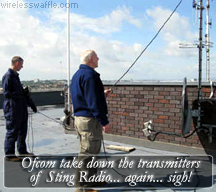 We recently discussed the idea that pirate radio could move to small-scale DAB radio services, or conversely that the closure of regular FM services might open up the FM band as a playground for even more pirates. But could there be yet another option... If Ofcom were to cease all enforcement activity on pirate radio (except in casese where it was causing interference to safety-of-life services) and let the illegal broadcasters run riot, the amount of intereference they would cause to legitimate stations would increase and this might be the incentive needed for those listeners to finally go out and buy a digital radio! So instead of continued enforcement, why not leave the pirates alone and see if that has the desired effect (in this case meaning 'forcing a move to digital radio').
We recently discussed the idea that pirate radio could move to small-scale DAB radio services, or conversely that the closure of regular FM services might open up the FM band as a playground for even more pirates. But could there be yet another option... If Ofcom were to cease all enforcement activity on pirate radio (except in casese where it was causing interference to safety-of-life services) and let the illegal broadcasters run riot, the amount of intereference they would cause to legitimate stations would increase and this might be the incentive needed for those listeners to finally go out and buy a digital radio! So instead of continued enforcement, why not leave the pirates alone and see if that has the desired effect (in this case meaning 'forcing a move to digital radio').
